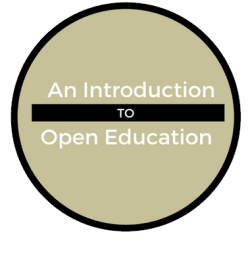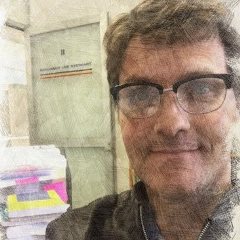
Below, I address copyright, public domain, and creative commons by discussing the following points, thinking mainly within the context of formal education:
- Effectively argue why protection of “intellectual property” is important and useful
- Explain the purpose of copyright (in the US)
- Critically evaluate the degree to which current copyright law appropriately balances limited incentives to creators and free public access to their works
- Define the public domain
- Describe the three components of a functioning Commons (An Introduction to Open Education).
Copyright (points 1, 2, & 3)
A copyright can be defined as “a government grant giving the copyright holder exclusive control over the reproduction of a literary, musical, or artistic work” (McAdams, 1995, p. 241). Clarkson, Miller, Jenna, & Cross (1992) define copyright slightly more broadly as “an intangible right granted by statute to the author or originator of certain literary or artistic productions (p. 162). They go on to state that any works created after January 1, 1978 remain protected by copyright law up to fifty years after the author’s death; publishing houses retain copyrights for a period of seventy-five years from the date of publication or a hundred years from the date of creation, whichever is first; and works by more than one author retain copyright protection for fifty years after the death of the last surviving author (p. 163).
Regarding international protection, if any American writes a book, his or her copyright in the book must be recognized by every country that has signed the Berne Convention of 1886 (Clarkson, et al. 1992). As of September 2016, there are 172 states that are parties to the Berne Convention, which includes 170 United Nations member states along with Holy See and Niue (Berne convention, n.d.). However, a solid international system of protection for intellectual property still is lacking and must rely on national legal systems for protection and proof of infringements, which still can be difficult to enforce (McAdams, 1995).
The government sees intellectual property as a form of wealth. Like other forms of wealth (e.g., patents, trademarks, etc.), intellectual property then should have certain protections by law. “Laws protecting patents, trademarks, and copyrights are explicitly designed to protect and reward inventive and artistic creativity” (Clarkson, 1992, p. 161). Thus, writers have the right to earn a living if there is a demand for their artistic creativity. If writers did not have this right: that is, they were not allowed to copyright any work whatsoever, there would be less incentive for creating the work in the first place. There remains an ethical and legal obligation for recognizing and protecting one’s original work when it comes to the creation of intellectual property.
Current copyright law does provide a defense for those who have unlawfully use copyrighted material. Under the “fair use” doctrine (i.e., the Copyright Act of 1976), copyrighted material may be used if the following are considered:
- “The purpose and character of the use, including whether such use is of a commercial nature or is for nonprofit educational purposes;
- the nature of the copyrighted work;
- the amount and substantial it’s of the portion used in relation to the copyrighted work as a whole; and
- the effect of the use upon the potential market for or value of the copyrighted work” (Band & Gerafi, 2013, p. 68).
Later, the Technology, Education, and Copyright Harmonization (TEACH) Act, signed by President George W. Bush on November 2, 2002, improved the Copyright Act of 1976, and applies to 1) institutions which are accredited as a non-profit educational institution, 2) the use of works as part of mediated instructional activities, 3) the use of works limited to a specific number of students enrolled in a specific class, and 4) the use of works either for ‘live’ or asynchronous class sessions. If these criteria are met, then…
- instructors may use a wider range of works in distance learning environments;
- students may participate in distance learning sessions from virtually any location; and
- participants enjoy greater latitude when it comes to storing, copying and digitizing materials (The TEACH Act, 2011).
The 112 Congress of The United States provided
further details regarding the TEACH Act depending on the particular purpose and context.
Although these provisions allow some flexibility in how copyrighted material may be used, copyrighting material is still limited when it comes to the use of textbooks and making education more open overall. Distance learning environments under the TEACH act would need to be closed and restricted to a rather small group of learners to the extent that it ends up being virtually the same as a small face-to-face (more traditional) classroom scenario. For this reason, alternatives to a more open learning environment are needed in order to make learning more equitable.
Public Domain (point 4)
“The term ‘public domain’ refers to creative materials that are not protected by intellectual property laws such as copyright, trademark, or patent laws” (Welcome to the Public Domain, 2017). Basically, no one owns a piece of work, nor can they ever own it… the public owns it. Works in the public domain are the most open and flexible since permission is not required (nor is giving attribution) to reuse, revise, remix, and/or redistribute the work.
Creative Commons (point 5)
Under a Creative Commons license (CC), one can use the work of another without getting permission, as long as attribution is provided (i.e., giving credit to the author, creator, etc.). Work under a CC can be for commercial or non-commercial purposes and CC can be applied to work that cannot be modified (i.e., non-derivative) or which can be modified. Some work under CC can only be used if subsequent licensing respect the original CC type while other cases allow subsequent CCs to vary depending on the discretion of author(s). A list of the CCs are as follows (most to the least open):
- CC0 = Public Domain
- CC BY = Creative Commons
- CC BY SA = Creative Commons Share Alike
- CC BY NC = Creative Commons Non-Commercial
- CC BY NC SA = Creative Commons Non-Commercial Share Alike
- CC BY ND = Creative Commons Non-Derivative
- CC BY NC ND = Creative Commons Non-Commercial Non-Derivative (Creative Commons license, n.d.).
In summary, the three components to a Creative Commons license are 1) commercial vs. non-commercial, 2) share alike vs. non-share alike, and 3) derivative vs. non-derivative. It’s worth noting that work in the public domain may be grouped and licensed together under a Creative Commons license (Welcome to the Public Domain, 2017).
Reaching out to the community…
- Regarding Americans and copyright protection covered by the Berne Convention, I assume expatriates (Americans residing outside of The United States) would enjoy the same protections?
- If anyone has a direct source listing the Berne Convention member states, please share by leaving a comment below.
- Admittedly, most of the sources in the copyright section are over 20 years old, so if any corrections are needed, please leave a comment below and changes to this post will be made.
Disclaimer
I am not an attorney (nor do I play one on TV – smile), so when making decisions about copyright and related protections, please seek the advice of a professional. Although I feel that Creative Commons license is generally the best option for promoting open education, information in this post is for informational purposes only. Making specific decisions about the best license will depend on the purpose and other considerations related to one´s own teaching and learning contexts: audience, distribution channels, local laws, etc.
References
Clarkson, K., Miller, R., Jentz, G., & Cross, F. (1992). West’s business law: Text cases legal and regulatory environment. New York, NY: West Publishing Company.
McAdams, T. (1995). Law, business, and society. Chicago, IL: Irwin, Inc.
Photo Attribution (Select image.)
 As I reflect back on #OpenEdMOOC, an introduction course on open education, I am reminded how essential transparency is to my own learning experiences. This week I am attending the 44th International MEXTESOL Conference in León, Mexico, and crave for the kind of sharing and communication that typically goes on at these kinds of events in my own day-to-day practice with colleagues I see face to face. #OpenEdMOOC, as MOOCs usually do, also exemplifies how individuals take it upon themselves to reach out and share knowledge and experiences so that others become aware. I find that the same moral obligation that drives me to share with my learners, is the same that drives me to share with colleagues.
As I reflect back on #OpenEdMOOC, an introduction course on open education, I am reminded how essential transparency is to my own learning experiences. This week I am attending the 44th International MEXTESOL Conference in León, Mexico, and crave for the kind of sharing and communication that typically goes on at these kinds of events in my own day-to-day practice with colleagues I see face to face. #OpenEdMOOC, as MOOCs usually do, also exemplifies how individuals take it upon themselves to reach out and share knowledge and experiences so that others become aware. I find that the same moral obligation that drives me to share with my learners, is the same that drives me to share with colleagues.









